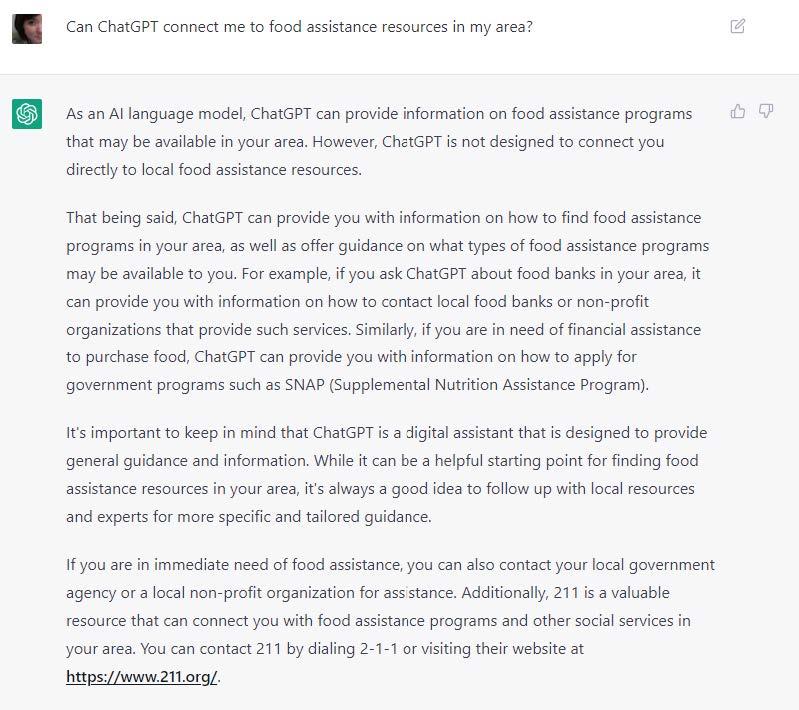ChatGPT is at the top of everyone’s mind—whether it is being used as a tool to help draft a cover letter, weekly meal plan, or even a 211.org blog post. But what happens when someone goes to ChatGPT for help?
To answer this question, I logged into my OpenAI account and started a new conversation with ChatGPT. The interface provided me a list of suggestions, capabilities, and limitations of the system, prompts that helped me consider how to open our conversation and made the blank page a bit less daunting as I determined how to begin asking for help. If you haven’t explored ChatGPT or other AI tools, it’s relevant to know that there is a particular art to asking the right question (providing the right input) to get a valuable response.
I approached the conversation from different angles, from directly asking ChatGPT where I could find food, to asking about the relationship between automation and social services. I included one common question across many of my conversations, “Can ChatGPT connect me to food assistance resources in my area?” and reflected on the how artificial intelligence could be used to help connect people to resources.
However, rather than having a standard set of responses on a given topic, ChatGPT learns and adapts as a conversation progresses. I started multiple different chat threads while working on this post, finding that my approach or phrasing steered the conversation in different directions.
In the end, ChatGPT provided me with general information on food insecurity, basic suggestions on how to find food resources, and, ultimately, suggested I reach out for additional help by calling 211, as 211 navigators are best equipped to understand and engage with my request and provide a customized list of potential local resources.
After my initial hesitancy when deciding how to frame my requests, I found it easy to dash out a response, start brand new chat threads, and ask ChatGPT new questions over and over again. Many individuals express hesitancy or fear in reaching out for help, and we’ve heard stories about how physically difficult it can be to pick up the phone and dial our three numbers. Could a chatbot be a gentler approach to that momentous first step? Emerging technologies and algorithms allow us to innovate and refine the ways we serve our communities, can AI be another entry point to connect people and resources?
According to the 2022 Impact Survey, around 38% of 211s use live two-way chat as a way for individuals to access 211. Nine 211s shared that they used chatbots, reporting a combined total of over 93,000 chatbot conversations of our 18 million requests for help in 2022. We know chat can be a valuable accessibility tool, with automation and routing capabilities that help 211s quickly send links and text to individuals at any time of day. ChatGPT felt approachable throughout my experience and referenced being able to offer “guidance and support” to users seeking information. I experienced some of ChatGPT’s attempts at reassurance when I asked for help finding specific resources, though those responses felt particularly scripted. Natural language processing allows the tool to mimic empathy, though the automated responses don’t evoke the same relief as hearing a warm voice asking, “how can I help?”
In addition to a gap in empathy, ChatGPT lacks the initiative or nuanced engagement of a trained community resource specialist, as it doesn’t always prompt follow-up questions and isn’t able to tease out secondary or underlying needs of a request. However, one of my conversations did end with the particularly delightful result of ChatGPT prompting me to call my local 211:

